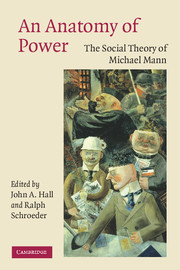Book contents
- Frontmatter
- Contents
- List of figures
- List of contributors
- 1 Introduction: the IEMP model and its critics
- Part I Theory, practice, method
- Part II Types of power
- Part III European exceptionalism?
- 10 From theory to history: ‘The European Dynamic’ or feudalism to capitalism?
- 11 The rise of the West
- 12 A historical, not comparative, method: breakthroughs and limitations in the theory and methodology of Michael Mann's analysis of power
- Part IV Promise and perils of modernity
- Part V Response
- Bibliography of Michael Mann's Writings
- Index
- References
12 - A historical, not comparative, method: breakthroughs and limitations in the theory and methodology of Michael Mann's analysis of power
Published online by Cambridge University Press: 22 September 2009
- Frontmatter
- Contents
- List of figures
- List of contributors
- 1 Introduction: the IEMP model and its critics
- Part I Theory, practice, method
- Part II Types of power
- Part III European exceptionalism?
- 10 From theory to history: ‘The European Dynamic’ or feudalism to capitalism?
- 11 The rise of the West
- 12 A historical, not comparative, method: breakthroughs and limitations in the theory and methodology of Michael Mann's analysis of power
- Part IV Promise and perils of modernity
- Part V Response
- Bibliography of Michael Mann's Writings
- Index
- References
Summary
Michael Mann's work ranges over such a vast array of periods and places – the prestate peoples of prehistory in the Old and New World; the ancient empires of Egypt, Assyria, Persia, Athens, Hellas, Rome; the varied states of Europe from the Middle Ages to the present; and excursions into India, China and the lands of Islam – that one's first reaction to my title might be: how could anyone claim that Mann's method is not comparative? Let me consult an expert who should know: Michael Mann. On p. 503 of the Sources of Social Power, Volume I (1986), he says: ‘Historical, not comparative, sociology has been my principal method.’ My purpose in this chapter is to explore the implications of this statement. I believe that this approach has allowed Mann to make several major breakthroughs in our understanding of states, their emergence and their development. For this, we will always be in his debt. At the same time, I wish to suggest that the limitations imposed by this choice have also led to problems in his theory of the emergence of the modern world.
Breakthroughs Mann's theory of state formation and development
Mann's theory of state formation and development offers some of the most striking and significant advances since Weber. This advance does not lie in his four-fold typology of power, the now famous IEMP quartet: ideological, economic, military and political power.
- Type
- Chapter
- Information
- An Anatomy of PowerThe Social Theory of Michael Mann, pp. 263 - 282Publisher: Cambridge University PressPrint publication year: 2006
References
- 6
- Cited by



